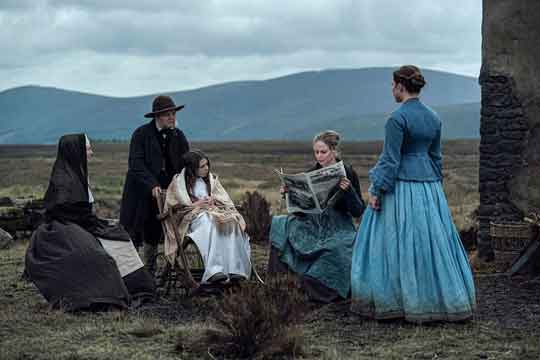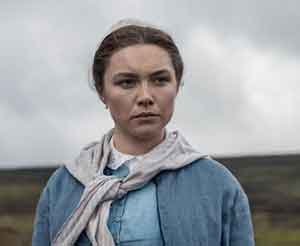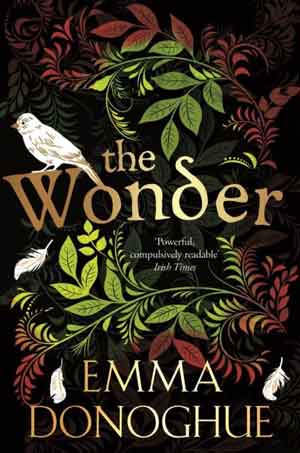THE WONDER
Published in Issue 2 (March/April 2023), Reviews, Volume 31Directed by Sebastián Lelio
By Maud Ellmann
Sebastián Lelio’s movie The Wonder (2022), based on Emma Donoghue’s 2016 novel of that name, stars Florence Pugh as English nurse Lib Wright, who is summoned to the Irish midlands in 1862 to stand watch over Anna O’Donnell, a pious eleven-year-old girl who claims to have lived for four months without food. Charged by the local patriarchy to probe this claim, Lib takes turns with Irish nun Sister Michael to monitor the child day and night, their alternation ensuring that secular medicine is counterbalanced by Catholic faith. In performing her vigil, Lib comes between mother Rosaleen O’Donnell and her daughter Anna, played by real-life mother and daughter Elaine Cassidy and Kíla Lord Cassidy, breaking up their deadly collusion. She also comes into conflict with the pompous male committee that commissioned her to supervise the fasting girl.
In her author’s note to The Wonder, Emma Donoghue explains that the novel was ‘inspired by almost fifty cases of so-called Fasting Girls—hailed for surviving without food for long periods—in the British Isles, Western Europe, and North America between the sixteenth and the twentieth centuries’. Among the most notorious was Sarah Jacob, known as ‘the Wonderful Little Girl’ for her miraculous ability to survive without food, which attracted trainloads of tourists to her remote village in a Welsh-speaking area of Wales. Doctors were sceptical, however, and in 1869 the girl’s parents agreed to bring her to Guy’s Hospital in London to be placed under 24-hour surveillance. Within two weeks the child was showing unmistakable signs of starvation, but her parents, though implored to call off the experiment, insisted on seeing it through. When Sarah died a few days later, her parents were convicted of manslaughter and sentenced to hard labour.
Scholars have shown how ‘holy anorexia’ became the signature form of female spirituality in the Middle Ages, and the secular phenomenon of the fasting girl draws force from this mystical tradition. But this figure also partakes of the sensationalism of the freak show, as in Kafka’s story The Hunger Artist, where self-starvation becomes a circus attraction. Both Donoghue’s novel and Lelio’s adaptation of The Wonder insinuate that the tourists who flock to the O’Donnells’ hovel to marvel at the miraculous child are motivated by prurience as much as by piety. Set in the ‘dead centre’ of Ireland, as one of Donoghue’s characters describes it, and surrounded by mementos of the potato famine, both novel and film revolve around the dead centre of hunger and its mysteries. Is the girl faking? Is she a marvel or a cheat? A saint or a pervert? Are her parents and neighbours deluded or colluding in the fraud? These questions drive the plot, providing both the novel and the film with the suspense of a ‘whodunnit’.
Lelio’s movie relocates the action from the dead centre of Athlone to the comelier countryside of County Wicklow, which provides a picturesque background for Lib’s Madonna-blue gown with its mud-soaked hem (who does the laundry, we wonder, in this boggy hinterland?). Apart from this geographical displacement, the film follows the novel as faithfully as Donoghue’s fans could wish. A collaboration between the director, Donoghue and Alice Birch, the riveting screenplay dramatises how Anna’s self-starvation is exploited by her family and the village elders. The doctor dreams of a medical breakthrough based on the fasting girl’s ability to live on air or photosynthesis; another bigwig insists that Anna is destined to be glorified as a latter-day saint; the priest, on the other hand, dreads the shame of her exposure as a hoax. The whole community has a financial interest in prolonging Anna’s fast for the generous tips donated by wonderstruck tourists. Murkiest of all are the mother’s motives for encouraging her daughter to starve, which emerge only at the end in a shattering revelation. In the film, the O’Donnells’ remote, gloomy cottage, with its bulging walls that seem to be encroaching on the living space, provides an apt setting for the incestuous psychodrama of the family. Donoghue has made herself a virtuoso of the novel of confinement; the dark claustrophobic world of The Wonder harks back to the garden shed in her 2010 novel Room—also made into a powerful film—where mother and child are imprisoned by a rapist.

Above: The cast of The Wonder— Sister Michael (Josie Walker), Dr McBrearty (Toby Jones), Anna O’Donnell (Kíla Lord Cassidy), Kitty O’Donnell (Niamh Algar) and Lib Wright (Florence Pugh). (Aidan Monaghan/Netflix)
Although the film of The Wonder cleaves closely to Donoghue’s text, there are several divergences from the novel, some less than felicitous. These include the corny alienation-effect at the beginning when the stage machinery is exposed, complete with scaffolding, while the voice of Kitty, the maidservant, played by Niamh Algar, intones that we ‘are nothing without stories’, a banality that conflicts with the film’s implication that stories—especially those of Christian sacrifice—can drive us to self-immolation. Donoghue, who has clearly done her medical homework, details the grisly physical effects of self-starvation, such as oedema, hair loss and blindness, whereas the film minimises these symptoms. Instead, Anna grows increasingly stony-faced, her unnerving gaze focused on the invisible. The film also plays up the Mills and Boon ending of the novel in which Lib’s lover, the roguish journalist William Byrne (played by Tom Burke of Strike fame), emerges as the knight in shining armour who rescues Anna from her toxic home, riding off with the child into the sunset.
Some reviewers have objected to this fairy-tale ending, which certainly clashes with the documentary tenor of the preceding narrative. Up until the final conflagration, both film and novel emulate the objectivity of a case history, with readers and viewers drawn into Lib’s role as watchdog, struggling to demystify the child’s deadly regimen. The film emphasises this objectivity by constantly portraying Lib in the humdrum act of eating, all glamour drained from Florence Pugh’s square-jawed face as she dutifully munches through her meals with no sign of enjoyment.
The film’s documentary mode clashes flagrantly, almost comically, with its Gothic denouement. But this generic volte-face, jarring though it seems, corresponds to the turn-around in which Lib is obliged to suspend her scientific knowledge and adopt her patient’s fanatical point of view. Sound medical advice will never persuade the girl to eat; only by entering Anna’s dream world, ringed with hell-fire, can Lib release her from her phantoms. Perhaps the film’s heavy-handed opening message may be interpreted in this way: we can’t get rid of stories, however lethal they may be, but can only cure fiction with fiction.
Maud Ellmann is the Randy L. and Melvin R. Berlin Professor of English at the University of Chicago.


















